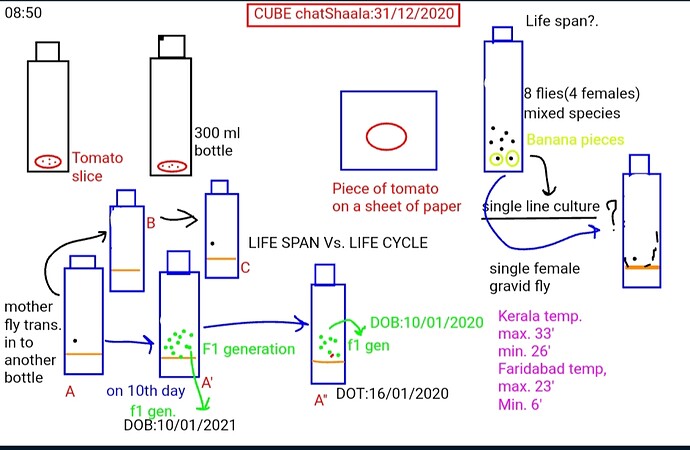Quoted by Aastha Ahuja
Yes ! So in our dry experiment our goal was to find out life span of fruit fly
So to know that we have to follow 3 steps :-
Trapping of flies
So to trap flies we will use tomato , banana , orange fruits as a bait to trap flies in a bottle of 500 ml. Then select one gravid female fly from that trap bottle to create single line cultures
Single line cultures ( replicates :- A, B, C bottle )
So the selected gravid fly is made to lay eggs in A bottle for 24 hours ( let’s call it day 1:- 1jan 2021 )
Then next day the gravid female fly is transferred to bottle B ( day - 2 :- 2Jan 2021 ) where it will lay the eggs for 24 hours in bottle B
Next day ( day :- 3 , 3 Jan 2021) we will transfer the gravid female fly in bottle C so that it can lay eggs in bottle C too … So we will now leave our gravid female fly in bottle C because our goal was to get 3 single line cultures from a single mother ( to create replicates for our experiment )
*What happens in bottle A in upcoming 20 days
On 1 Jan 2021 eggs were layed in bottle A which are expected to convert into flies in 10 days since the temperature in faridabad is low ( 23°C max , 6°C min) a longer time for flies to complete their life cycle is expected in low temperature area . so on 10 Jan flies are expected to emerge from pupa .
Now next problem :- we wanted to know the birth and death date of these flies , so we cannot allow them to get mixed with next generation flies which are expected to emerge in next 12 days …
So for that we expect that flies will attain their sexual maturity in 2 days post their birth and they will start to lay eggs too , so on 12 Jan 2021 they are expected to lay eggs which will convert into pupa in another 6 days
So as soon as we see the first pupa in bottle A ( also called A’ ) we will transfer flies from A’ to A"
20 Jan 2021- A’ bottle - F2 generation flies
20 Jan 2021- A" bottle flies whose birth date is 10 Jan 2021
This process of separation of flies with birth date 10 Jan 2021 from F2 generation , will take place every week until their death
Similar things are expected to happen in bottle B but one day late , and bottle C 2days post to bottle A
This was the dry experiment which we all did yesterday
I hope that I didnt complicate things more 


